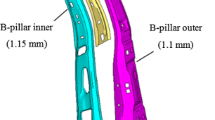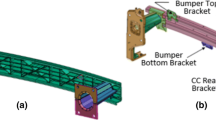Abstract
A composite B-pillar was designed and manufactured by design optimization combined with an impact analysis. A carbon-fiber-reinforced plastic (CFRP) was used for the reinforcement part of the B-pillar assembly to substitute the conventional steel materials for reducing the weight of vehicle. To maximize the impact performance by finite element method, the equivalent static loads method was used. The shape, stacking sequence, and thickness of the CFRP reinforcement were optimized to minimize the deflection profile for improving the crashworthiness while reducing the weight. The designed CFRP B-pillar was manufactured and its performance was evaluated by a drop weight test. As a result, the CFRP B-pillar exhibited an improved impact performance and reduced weight compared to those of the conventional steel B-pillar.











Similar content being viewed by others
References
Smith, M., & Crotty, J. (2008). Environmental regulation and innovation driving ecological design in the UK automotive industry. Business Strategy and the Environment, 17(6), 341–349.
Mcauley, J. W. (2003). Global sustainability and key needs in future automotive design. Environmental Science and Technology, 37(23), 5414–5416.
Wells, P., Varma, A., Newman, D., Kay, D., Gibson, G., Beevor, J., et al. (2013). Governmental regulation impact on producers and consumers: A longitudinal analysis of the European automotive market. Transportation Research Part A: Policy and Practice, 47, 28–41.
Lee, J.-M., Lee, K.-H., Kim, B.-M., & Ko, D.-C. (2016). Design of roof panel with required bending stiffness using CFRP laminates. International Journal of Precision Engineering and Manufacturing, 17(4), 479–485.
Fuchs, E. R., Field, F. R., Roth, R., & Kirchain, R. E. (2008). Strategic materials selection in the automobile body: Economic opportunities for polymer composite design. Composites Science and Technology, 68(9), 1989–2002.
Beardmore, P., & Johnson, C. (1986). The potential for composites in structural automotive applications. Composites Science and Technology, 26(4), 251–281.
Siregar, J. P., Jaafar, J., Cionita, T., Jie, C. C., Bachtiar, D., Rejab, M. R. M., et al. (2019). The effect of maleic anhydride polyethylene on mechanical properties of pineapple leaf fibre reinforced polylactic acid composites. International Journal of Precision Engineering and Manufacturing-Green Technology, 6(1), 101–112.
Gustafsson, F. (2009). Automotive safety systems. IEEE Signal Processing Magazine, 26(4), 32–47.
Leonardi, P. M. (2010). From road to lab to math: The co-evolution of technological, regulatory, and organizational innovations for automotive crash testing. Social Studies of Science, 40(2), 243–274. https://doi.org/10.1177/0306312709346079.
Kim, H.-S., Lee, Y.-S., Yang, S.-M., & Kang, H. Y. (2016). Structural analysis on variable characteristics of automotive seat frame by FEA. International Journal of Precision Engineering and Manufacturing-Green Technology, 3(1), 75–79.
Huh, H., Lim, J., Song, J., Lee, K., Lee, Y., & Han, S. (2003). Crashworthiness assessment of side impact of an auto-body with 60TRIP steel for side members. International Journal of Automotive Technology, 4, 149–156.
Marklund, P.-O., & Nilsson, L. (2001). Optimization of a car body component subjected to side impact. Structural and Multidisciplinary Optimization, 21(5), 383–392.
Sinha, K., Krishnan, R., & Raghavendra, D. (2007). Multi-objective robust optimisation for crashworthiness during side impact. International Journal of Vehicle Design, 43(1–4), 116–135.
Boria, S., & Belingardi, G. (2012). Numerical investigation of energy absorbers in composite materials for automotive applications. International Journal of Crashworthiness, 17(4), 345–356.
Kim, D.-H., Jung, K.-H., Kim, D.-J., Park, S.-H., Kim, D.-H., Lim, J., et al. (2017). Improving pedestrian safety via the optimization of composite hood structures for automobiles based on the equivalent static load method. Composite Structures, 176, 780–789.
Mastura, M., Sapuan, S., Mansor, M., & Nuraini, A. (2018). Materials selection of thermoplastic matrices for ‘green’ natural fibre composites for automotive anti-roll bar with particular emphasis on the environment. International Journal of Precision Engineering and Manufacturing-Green Technology, 5(1), 111–119.
Bae, G.-H., & Huh, H. (2012). Comparison of the optimum designs of center pillar assembly of an auto-body between conventional steel and ahss with a simplified side impact analysis. International Journal of Automotive Technology, 13(2), 205–213.
Bok, H.-H., Lee, M.-G., Pavlina, E. J., Barlat, F., & Kim, H.-D. (2011). Comparative study of the prediction of microstructure and mechanical properties for a hot-stamped B-pillar reinforcing part. International Journal of Mechanical Sciences, 53(9), 744–752.
Friedrich, K., & Almajid, A. A. (2013). Manufacturing aspects of advanced polymer composites for automotive applications. Applied Composite Materials, 20(2), 107–128.
Lee, J.-M., Kim, B.-M., Min, B.-J., Park, J.-H., & Ko, D.-C. (2017). Formability of CFRTP prepreg considering heat transfer. International Journal of Precision Engineering and Manufacturing-Green Technology, 4(2), 161–168.
Kim, J.-W., & Lee, D.-G. (2014). Study on the fiber orientation during compression molding of reinforced thermoplastic composites. International Journal of Precision Engineering and Manufacturing-Green Technology, 1(4), 335–339.
Liu, H., Falzon, B. G., & Tan, W. (2018). Experimental and numerical studies on the impact response of damage-tolerant hybrid unidirectional/woven carbon-fibre reinforced composite laminates. Composites Part B Engineering, 136, 101–118.
Park, J. L., Chi, Y.-S., & Kang, T. J. (2013). Ballistic performance of hybrid panels composed of unidirectional/woven fabrics. Textile Research Journal, 83(5), 471–486.
Johnson, K., Butler, R., Loukaides, E., Scarth, C., & Rhead, A. (2019). Stacking sequence selection for defect-free forming of uni-directional ply laminates. Composites Science and Technology, 171, 34–43.
Hitchen, S. A., & Kemp, R. (1995). The effect of stacking sequence on impact damage in a carbon fibre/epoxy composite. Composites, 26(3), 207–214.
WILHELMSSON, D. (2016). On matrix-driven failure in unidirectional NCF composites. Tekn. Lic Thesis. Chalmers Univ of Techn, Gothenburg.
Irisarri, F.-X., Bassir, D. H., Carrere, N., & Maire, J.-F. (2009). Multiobjective stacking sequence optimization for laminated composite structures. Composites Science and Technology, 69(7–8), 983–990.
Park, G.-J. (2010) Equivalent static loads method for non linear static response structural optimization. In 9th LS-DYNA German User’s Forum, Bamberg, Germany.
Vanderplaats, G. N. (1984). An efficient feasible directions algorithm for design synthesis. AIAA Journal, 22(11), 1633–1640.
Venter, G., & Watson, B. (2000). Exploiting parallelism in general purpose optimization. WIT Transactions on Information and Communication Technologies. https://doi.org/10.2495/HPC000021.
Yang, S., & Lee, Y. (1993). Optimization of noncollocated sensor/actuator location and feedback gain in control systems. Smart Materials and Structures, 2(2), 96.
Astm, D. (2005). 5379. Standard test method for shear properties of composite materials by the V-notched beam method. ASTM International, 15, 241–253.
ASTM D3039. (2008). Standard test method for tensile properties of polymer matrix composite materials (pp. 1–13). West Conshohocken, PA: ASTM International.
ASTM D6641. (2009). Standard test method for compressive properties of polymer matrix composite materials using a combined loading compression (CLC) test fixture (pp. 1–9). West Conshohocken, PA: ASTM International.
Acknowledgements
This work was supported by a National Research Foundation of Korea (NRF), funded by the Ministry of Education (2018R1D1A1A09083236). This research was also supported by a National Research Foundation of Korea (NRF) grant funded by the Korean Government (MEST) (2013M2A2A9043280). This work was also supported by the Industrial Strategic technology development program (10076562, Development of fiber reinforced thermoplastic nano-composite via fiber bundle spreading for high quality resin impregnation process and its application to the underbody shield component for protecting battery pack of an electric-vehicle) funded By the Ministry of Trade, industry & Energy(MI, Korea). This work was also supported by a Collaborative Project between Hanyang University and Hyundai Motors Co. Ltd.
Author information
Authors and Affiliations
Corresponding author
Additional information
Publisher's Note
Springer Nature remains neutral with regard to jurisdictional claims in published maps and institutional affiliations.
Rights and permissions
About this article
Cite this article
Kim, DJ., Lim, J., Nam, B. et al. Design and Manufacture of Automotive Hybrid Steel/Carbon Fiber Composite B-Pillar Component with High Crashworthiness. Int. J. of Precis. Eng. and Manuf.-Green Tech. 8, 547–559 (2021). https://doi.org/10.1007/s40684-020-00188-5
Received:
Revised:
Accepted:
Published:
Issue Date:
DOI: https://doi.org/10.1007/s40684-020-00188-5




